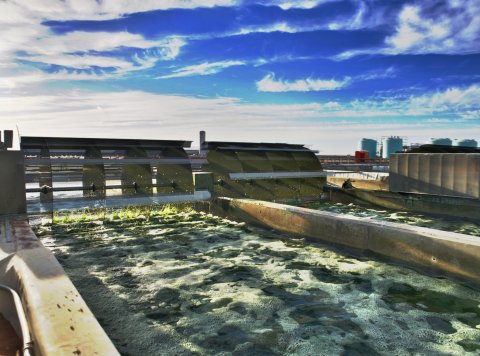Algae shows great potential as a homegrown and renewable fuel source. Here's why it will be a big part of our nation’s energy mix sooner than you might expect.
July 29, 2015Tiny algae organisms have big potential for America’s clean energy future. These microscopic green machines convert sunlight into energy, storing it in the form of natural oils that can be extracted to fuel planes, cars and trains. It’s estimated that under the right conditions, algae could produce up to 60 times more oil per acre than land-based plants.
Since algae needs carbon dioxide to grow, it takes greenhouse gases out of the atmosphere, making it nearly carbon-neutral. In addition, algae can grow in a variety of environments -- including man-made ponds, brackish water and wastewater.
While algae shows great potential as a homegrown and renewable fuel source, just how far away is this promise from becoming a reality? Here are three reasons why we should expect algal biofuels to become a major contributor to our nation’s energy mix sooner rather than later.
Production is up.
Recently, researchers at the Scripps Institution of Oceanography genetically engineered algae to boost the amount of energy-storing molecules essential for making oil, signaling a breakthrough in algal biofuel production. | Photo by National Renewable Energy Laboratory.
Logistical problems are being solved.
Algal biorefineries are scaling up -- big time.
Watch this Energy 101 video to see how algal biofuels work, and go to energy.gov/algae for more details on the Energy Department’s efforts to make this clean, renewable fuel source more affordable and sustainable. Also, read this article to find out how algae can be used to make other products (like surfboards)!
Paul Lester

Paul Lester served as Digital Content Specialist in the Office of Public Affairs.
Paul was born in Ohio but spent most of his life in Florida, where he worked as news researcher/archivist and online editor for the Orlando Sentinel.
He moved to Washington in 2008 for a web editor role with the Guardian before working as a contractor for the Wind and Water Technologies Office, Small Business Administration and Office of Energy Efficiency and Renewable Energy.
Paul joined the Energy.gov team in March 2015, contributing to Energy Blog and assisting with managing the Energy Department’s social media channels. When he’s not in the office, Paul can be seen slowly running around D.C. training for his next half marathon.




